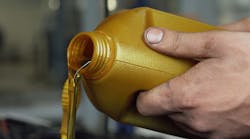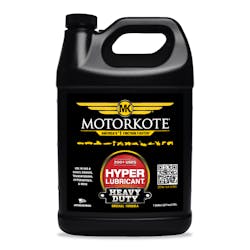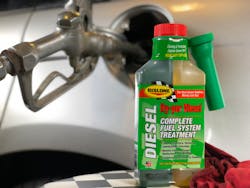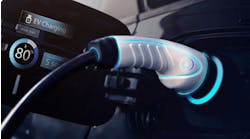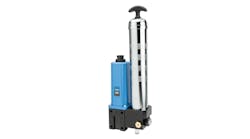The global fuel and oil additive market, which exists to boost fuel and engine oil efficiency and vehicle performance, is already very sizable—at over $10 billion, according to Technavio—and continues to grow. According to Data Bridge Market Research, the diesel bottled fuel additive sector will see a compound annual growth rate of 6.5% from 2022 to 2029.
Even so, not all fleets are sold on their purported benefits, such as improved fuel economy. Plus, additives introduce another layer of expense on top of rising fuel costs. But for fleets using additives, rising costs seem to be the biggest motivator.
Additives can be seen as vitamin for the enigne, as the quality of fuel at truck stops can vary as greatly as the food sold inside of them. They essentially are designed to compensate for and even boost lower-quality diesel.
“What it comes down to is that we really don’t know what quality we’re getting at the pump today,” said Josh Steinmetz, e-commerce and digital marketing manager at Lubrication Specialties, a provider of oil, lubricants, and additives whose brand names include Hot Shot’s Secret. “Station 1 might have a certain quality of fuel, and Station 2 across the street is likely a different quality.”
Knowing the precise quality is necessary for fleets that rely on a certain level of engine performance to stay profitable.
“Today’s equipment runs on such tighter tolerances that the fuel needs to be at the optimum level to not only perform well, but also reduce breakdowns and trips to the repair shop,” Steinmetz added.
Additives also boast about improving performance. Oil additive companies, for example, have a lot of things they put into their chemistries to precisely dial in certain levels of performance. That said, with CK-4 and FA-4 oils emerging over the past several years, fuel economy has become a larger factor.
“The OEMs have recognized that they need to provide durability and wear protection, but also need ways to get more efficiency out of the engine,” said Greg Matheson, product manager for commercial engine lubricants at Lubrizol, a specialty chemicals company whose oil, fuel, and lubricant additives are used by a variety of OEMs and aftermarket marketers. “So, as an additive company, we need to really look at that fuel economy piece.”
The other potential benefits of additives can be a big deal, too, including reduced maintenance, cleaner exhaust, and perhaps even stronger used-vehicle resale values.
See also: How to spec the right engine oil for better efficiency and performanceAccording to Ed Gibbs, EVP of marketing at MotorKote, a supplier of additives and lubricants for gasoline and heavy-duty diesel engines, the ROI generated from additives are hard to ignore. Gibbs, a regular on the popular radio show “America’s Truckin’ Network” for nearly 20 years, which earned him the moniker “Mr. MotorKote,” said he recently took a call from a fleet operator who claimed that for every dollar of MotorKote products he used, he recovered six dollars.
“The added bonus was that in the used-vehicle market, this guy became very respected for having the best trucks around,” Gibbs related. “This guy told me he actually had a waiting list for his trucks because everything was so clean and well-maintained.”
Signs you might need an additive
When you get down to it, though, most fleets that begin using various additives do so in order to solve an immediate problem. There are certain warning signs fleets can watch for that might suggest an additive could help.
“Most fleets are tracking fuel mileage pretty closely now,” said Clay Parks, VP of strategic development for the Bar’s Leaks and Rislone brands of stop leaks, engine treatments and fuel additives. “If the fleet is seeing a gradual decline in fuel economy, there’s a pretty good chance it is fuel related. Black smoke coming out of the exhaust, especially on newer vehicles, is a big sign. Unusual noise in the exhaust is something else to look for.”
A technician may also notice deposit issues with the fuel injectors or other parts of the fuel system, signaling the potential need for a fuel additive with cleaning properties.
“For older diesel trucks, there is also often a need for lubricating additives,” Parks added. “With a reduction in the sulfur in fuel, a lot of the lubrication ability inside of those systems has been lost. There are even benefits to some of the newer diesel models since lubricating additives can also help with injector stiction.”
Stiction refers to the sticky residue on moving engine parts from burnt oil. While some additives are designed to take care of one problem, such as stiction, others are designed to tackle several problems.
Motorkote’s Gibbs advised fleets to be skeptical of products that claim to do too many things. “With each additive in a final product, you have to hit on the right percentage of concentration for it to work,” he explained.
Parks agreed with that sentiment—to a certain degree. “Nine times out of 10, dedicated products are a bit stronger,” Parks said. “But when you look at the claims made on the product data sheet, users will meet all of the claims with the additives that are in that product.”
It really comes down to fleets understanding what a given additive is capable of doing and whether or not that performance level will satisfy the expectation they have.
“We formulate our products to the max level, so there aren’t any fillers,” said Steinmetz of Hot Shot’s Secret. “That allows us to do several things well, together. We’ve also found that we get synergies between different components. For example, lubricity can be improved with a lubricity improver, but also some of the other ingredients in the product. When you use one additive to do one thing, you can’t benefit from those synergies. So that’s how our chemists go out and find the best products to use together to create the best formulations.”
Engine oil additives
Lubrizol’s Matheson said fleets running the newer CK-4 and FA-4 engine oils have a need for additives. Because modern engines are more compact with less clearance between components, engines run hotter and require enhanced protection against oxidation and corrosion.
“Lubrizol’s technologies have evolved to include ingredients like anti-oxidants, friction-reduction agents, as well as detergents and dispersants to keep engine components free of deposits and acids that can build up,” Matheson pointed out.
To get to the optimum formulation, Lubrizol chemists perform extensive testing. First, standard API licensing tests are conducted. “Outside of that, we do extensive field testing in the real world,” Matheson said. “For the CK-4 and FA-4 products that are on the market today, we have tested over 75 million miles running up and down the road. A lot of the testing we do is with our customers. In many cases, the marketers of the final additive treatment product have the same data we do. Fleets should always ask their oil and additive suppliers about the field-testing data they have.”
Hot Shot’s Secret, for example, has compiled quite a bit of data of its own. In one of their many third-party field studies, a trucking firm called Blackrock Logistics tested three standard freight trucks with two of Hot Shot’s Secret additives. Stiction Eliminator, a blend of synthetic cleaner and proprietary lubricant, was used in oil systems. Diesel Extreme, a concentrated injector cleaner and cetane booster, was added to fuel tanks. By using both additives, as opposed to just one or the other, maintenance costs were reduced by more than half. Drivers also reported a noticeable increase in power.
To that point, MotorKote’s Gibbs said he often hears from radio show callers that using both an oil and fuel additive can help improve fuel economy by as much as 6 mpg.
Fuel additives
The conversation about fuel additives begins with the fuel they are created to supplement.
“Diesel fuel specs in the U.S. have been relatively loose when compared to other countries,” said Kevin Griffith, product manager for diesel fuel additives at Lubrizol. “The heavier duty equipment has generally been able to handle that fuel for the past couple of decades. The big changes have come with the bigger push for emission reduction and fuel economy. Now, you’re starting to see different conditions that are happening with these newer heavy-duty diesel engines.”
As mentioned earlier, new engines tend to run hotter today. That can lead to an increased level of deposit formation inside the injectors and on the injector tips. “A fleet could end up seeing significantly decreased performance due to a blocked injector flow,” Griffith explained. “Lower horsepower and torque output can lead to worse fuel economy and emissions.”
For that reason, a fuel additive designed to clean and prevent deposits can prove to be a good investment for a fleet, particularly fleets running higher duty cycles such as vocational or city delivery.
“Each fleet is unique with its own working load on its vehicles,” Griffith said. “That’s why I always caution fleets to not completely accept the claims on an additive bottle as what they can expect. Explain your situation to the additive supplier and ask what a realistic expectation is. A lot of starting, stopping, and idling can lead to deposits faster which can impact performance and also create exhaust issues. On the other hand, long-haul applications will still likely benefit from a fuel additive, but should maybe set their expectations a bit lower, perhaps in the few-percent improvement range.”
In addition to deposit control, Griffith said several other additives can come into play with fuel. The most common is a lubricity improver, driven by the move to a lower-sulfur fuel specification which has resulted in reduced friction modifier benefits. “In other words, this fuel is a bit rougher on metal surfaces which can lead to increased wear on things like fuel pumps,” Griffith explained.
Since there is a North American standard relating to wear scar, Griffith said most fuel additives will provide some degree of lubricity improvement. The question is, how much?
“The North American specification for wear scar is much easier to meet than other regions, such as Europe,” Griffith pointed out. “So, there is still plenty of room to improve fuel lubricity. This is where a fleet may want to treat itself because the fuel coming out of the pump might not deliver the highest performance in this area. The fleet can take it upon itself to add additional additives to better protect its equipment, especially if the fleet plans on hanging on to that equipment for a long time.”
See also: EDT+ Winter Defense Diesel Fuel AdditiveOne other consideration with fuel additives relates to cold-temperature operation. Additives containing cold-flow, anti-gel properties can benefit any fleet operating in cold environments, including southern fleets driving into northern markets.
Finally, fuel additives can result in an important side benefit: better aftertreatment system performance. Cleaner-burning fuel results in cleaner exhaust. According to Hot Shot’s Secret’s Steinmetz, adding cetane to a fuel additive is one of the easiest and most effective ways to improve DPF regens.
Speaking of DPF regens, there are other additive products available that are specifically designed to tackle this challenge head-on.
For instance, Lucas Oil’s Diesel Deep Clean is marketed as a particulate filter cleaner and power booster thanks to its ability to deep clean the entire fuel and exhaust system. According to the company, particulate matter can be reduced by up to 32% when used correctly, helping to improve regen efficiency.
Another example is MotorKote’s DEF Reducer. This additive is designed to enable the combustion fuel catalyst to allow fuel to burn cleaner and more efficiently. That can result in less soot and filter contamination, resulting in a cleaner DPF that can last longer, which results in less DEF consumption—hence the product’s name. Gibbs said field data shows that proper use of DEF Reducer can reduce regens by up to 80%.
Rislone is working on an additive of its own that relates directly to the DPF. “A lot of fleets are dealing with more frequent regens and fault codes,” Parks said. “The product we’re working on is designed to help reduce the number of regen cycles.”
If there is a fuel- or oil-related headache fleets encounter, you can bet that additive formulators are working on a solution. Every fleet has different assets, applications, and expectations. Whether or not a given fleet decides to buy in to the use of additives is up to that individual fleet. Nowadays, the decision can be motivated by not just packaging sales sizzle, but science from the lab and performance data from the field.
